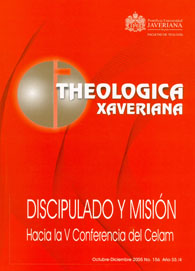Abstract
Los discípulos y discípulas son ante todo seguidores y seguidoras de Jesucristo, el Señor. La dinámica del discipulado se comprende como un proceso de práctica histórica situada en perspectiva del seguimiento y no de pertenencia a una escuela. Esta práctica es funcional al Reino, a su implantación desde ya y por lo mismo teniendo como referente la preservación y defensa de la vida, de la creación y de la humanidad. Por ello el discipulado busca que en Cristo, nuestros pueblos tengan vida.AUSTIN, J.L., Quand dire c’est faire, aux, Éditions du Seuil, Paris, 1970.
CASSIDY, R.J., Jesús Politics and Society, a study of Luke’s Gospel, Orbis Books, Maryknoll, New York, 1978.
CASTILLO, J.M., Nuevos ministerios en las comunidades eclesiales. Reseña de
un coloquio internacional, Seminarios, Salamanca, 19 No. 51, 1973.
CHAPENTIER, E., Des Evangiles á l’Evangile, Paris, Centurion, 1976.
DELORME, J., Des Evangiles á Jesús, Paris, Fleurus, 1972.
DESCAMPS, A., Pour une histoire du tigre ‘Fils de Dieu’. Les antécédents par raport a Marc. L’Evangile selon Marc, Leuven-Gembloux, Leuven
University Press-Duculot, 1974.
DODD, CH., Evengile et histoire, Cerf, Paris, 1974.
DUFOUR, X.L., Les Evangiles et l’histoire de Jesús, Paris, Seuil, 1963.
DUPONT, J., Les ministéres de l’Eglise naissante d’aprés les Actes des Aportes, ver: Ministéres et célebration de l’Eucaristhie, Editrice Ansel-miana, Roma, 1973.
GESCHE, A., L’homme, Ed Cerf, París.
GONZÁLEZ, A., Reinado de Dios e imperio, Sal Terrae, Santander, 2003.
GUTIÉRREZ, G., Teología de la liberación, perspectivas, Sígueme, Salamanca,1975.
HARRINGTON, W., Nouvelle Introduction á la Bible, Seuil, Paris, 1971.
HENGEL, M., El Hijo de Dios, el origen de la cristología y la historia de la religión judeo-cristiana, Sígueme, Salamanca, 1977.
HENGEL, M., Seguimiento y carisma, la radicalidad de la llamada de Jesús, SalTerrae, Santander, 1981.
KASPER, W., Fe e historia, Salamanca, Sígueme, 1974.
MADERA, I., El seguimiento de Jesús, Epistemología y práctica, Louvain-la-Neuve, 1983.
MADERA, I., “Ética cristiana y globalización”, ponencia presentada en el VI
Congreso Latinoamericano de Teología Moral, Sao Paulo, diciembre 15 de 2005.
MATEOS, J., Los Doce y otros seguidores de Jesús en el Evangelio de Marcos, Ed. Cristiandad, Madrid, 1982.
MCDERMOTT, J.M., “Jesus and the Son of God Title”, en Gregorianum, Italia, 62 No. 2, 1981.
MO SUNG, J., Sujeto y sociedades complejas, DEI, San José de Costa Rica, 2005.
NIDA, E.A., Implications of Comtemporary linguistics for Biblical Scholarship, Journal of Biblical Literatura, New Cork, New Haven Conn., Philadelphia, 1972.
This journal is registered under a Creative Commons Attribution 4.0 International Public License. Thus, this work may be reproduced, distributed, and publicly shared in digital format, as long as the names of the authors and Pontificia Universidad Javeriana are acknowledged. Others are allowed to quote, adapt, transform, auto-archive, republish, and create based on this material, for any purpose (even commercial ones), provided the authorship is duly acknowledged, a link to the original work is provided, and it is specified if changes have been made. Pontificia Universidad Javeriana does not hold the rights of published works and the authors are solely responsible for the contents of their works; they keep the moral, intellectual, privacy, and publicity rights.
Approving the intervention of the work (review, copy-editing, translation, layout) and the following outreach, are granted through an use license and not through an assignment of rights. This means the journal and Pontificia Universidad Javeriana cannot be held responsible for any ethical malpractice by the authors. As a consequence of the protection granted by the use license, the journal is not required to publish recantations or modify information already published, unless the errata stems from the editorial management process. Publishing contents in this journal does not generate royalties for contributors.


